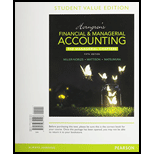
1.
Bonds: Bonds are long-term promissory notes that are represented by a company while borrowing money from investors to raise fund for financing the operations.
Bonds Payable: Bonds payable are referred to long-term debts of the business, issued to various lenders known as bondholders, generally in multiples of $1,000 per bond, to raise fund for financing the operations.
To prepare:
2.
To prepare: Journal entry to record semiannual interest and amortization of premium on bonds.
3.
To prepare: Journal entry to record semiannual interest and amortization of premium on bonds.
4.
To prepare: Journal entry to record the retirement of bond payable at maturity.
Want to see the full answer?
Check out a sample textbook solution
Chapter 12 Solutions
Horngren's Financial & Managerial Accounting, The Managerial Chapters, Student Value Edition (5th Edition)
- How much is the budgeted cost of goods sold for 2024?arrow_forwardDetermine net sales for the companyarrow_forwardThe ending inventory of Thornton Supplies Inc. is $45,000. If the beginning inventory was $62,000 and goods available for sale totaled $148,000, what is the cost of goods sold?arrow_forward
- Compute the amount of underapplid or overaplied overhead cost for the yeararrow_forwardRegency Distributors wants an ending inventory each month equal to 20% of that month's cost of sales. Cost of sales for April is projected at $150,000. Ending inventory at the end of March was $25,000. Based on this information, purchases for April will be: a. $125,000 b. $130,000 c. $145,000 d. $155,000arrow_forwardPlease solve this General accounting questions step by steparrow_forward
- Principles of Accounting Volume 1AccountingISBN:9781947172685Author:OpenStaxPublisher:OpenStax College
 Financial Accounting: The Impact on Decision Make...AccountingISBN:9781305654174Author:Gary A. Porter, Curtis L. NortonPublisher:Cengage Learning
Financial Accounting: The Impact on Decision Make...AccountingISBN:9781305654174Author:Gary A. Porter, Curtis L. NortonPublisher:Cengage Learning Cornerstones of Financial AccountingAccountingISBN:9781337690881Author:Jay Rich, Jeff JonesPublisher:Cengage Learning
Cornerstones of Financial AccountingAccountingISBN:9781337690881Author:Jay Rich, Jeff JonesPublisher:Cengage Learning  Excel Applications for Accounting PrinciplesAccountingISBN:9781111581565Author:Gaylord N. SmithPublisher:Cengage Learning
Excel Applications for Accounting PrinciplesAccountingISBN:9781111581565Author:Gaylord N. SmithPublisher:Cengage Learning College Accounting, Chapters 1-27AccountingISBN:9781337794756Author:HEINTZ, James A.Publisher:Cengage Learning,
College Accounting, Chapters 1-27AccountingISBN:9781337794756Author:HEINTZ, James A.Publisher:Cengage Learning, Financial AccountingAccountingISBN:9781305088436Author:Carl Warren, Jim Reeve, Jonathan DuchacPublisher:Cengage Learning
Financial AccountingAccountingISBN:9781305088436Author:Carl Warren, Jim Reeve, Jonathan DuchacPublisher:Cengage Learning





